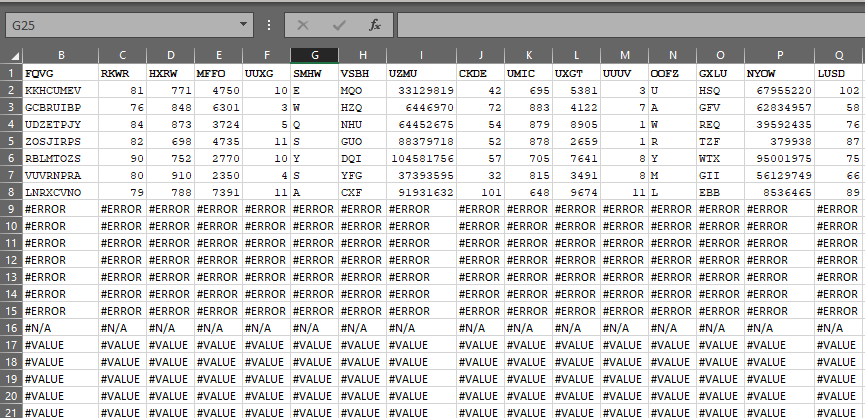
How Perpetual Inventory Software Can Help Growers
June 7, 2022
10 Reasons ERP Consulting Drives Grower Software System Transition Success
July 26, 2022Let’s be honest, for majority of businesses today Microsoft Excel is still the ‘data interface’, even for growers that have large scale, very expensive, back-end ERP type systems in place.
Excel has powerful features, it’s easy to use and nearly ubiquitous. However, with those great features come some additional potential risks that growers may want to consider before staking their business operational data on only Excel*. Excel makes “quick and dirty” solutions easy and allows for a near universal format to transfer data and most people know how to use it.
Growers have a complex job and a complex data model to manage. When you couple that with the flexibility they need to deal with market, supplier, or crop situations it makes for a difficult equation to solve from the software perspective. Thus, many growers tend to fall back on it in lieu of purchasing and using more bespoke software for our industry.
If you choose to use Excel to manage all our grower data here are a few points to be aware of.
Data Integrity
I have worked with many clients where Excel figured heavily in their processes and where the actual data had many errors, data duplications, and inconsistencies.
Not everyone can build a formula correctly, and not everyone can understand relative vs absolute cell addressing. As formulas and equations get complex and the number of inter-related sheets grows, it is easy to make ‘cut and paste’ mistakes that impact the answers you see.
According to this Forbes article, 88% of spreadsheets have errors in them. Yikes.
If you are relying on Excel for critical business data or function, be aware errors are easy to introduce and sometimes hard to track down.

Historical Changes
Excel desktop currently doesn’t allow granular recording of historical changes, like a change log in a software project or database.
I have seen multiple examples where a grower’s employees accidentally changed key elements of multiple dependent worksheets that caused errors or malfunctions in downstream dependent calculations. Some of these errors weren’t caught until it was too late. The wrong material was purchased or planted or shipped to the wrong customer. And, due to the lack of change control, it was difficult to figure out who made changes or what specifically they were.
Bulk Changes
The filtering capability of Excel is very powerful and with flash fill features you can do bulk edits of hundreds of records very quickly.
However, I have found that unless your filtering is very granular, bulk changes can cause issues, leading to records that were changed that should not have been or to records that were missed that should have been changed.
In fact, I have updated large sheets with multiple filter criteria set when I should have had one filter set differently. The filtered bulk edit in Excel is very fast and powerful to bulk change but you must make sure the filter criteria are correct. When you have a spreadsheet that goes out to column “CZ”**, it can get difficult to see various criteria and make sure they are all correct before you make big edits.
Integrations
Traditional Excel, which is what most growers still use, does not connect to disparate data sources easily. The setup is sometimes confusing and can lead to situations where data access credentials are stored in the worksheet, which is not a good security practice.
Certainly, newer versions of excel using the PowerQuery feature can bring in many types of data (and help overcome the 1,000,000 row limit on a standard worksheet). However not all the Excel features you are used to using work on those PowerQuery data sets.
Excel can also use API calls to web data services with its macro and VBA language. But most users are not comfortable or knowledgeable about these mechanisms and how to best use them.
Obsolescence

If a grower is using spreadsheets with macros to do planning or purchasing, for example, even those implementations can be complicated.
Excel does offer a powerful macro language, but it does require some training and understanding to fully benefit and to certainly troubleshoot when things go wrong.
I have talked to several growers who had a friend, family member or associate build some set of complicated macros that were used and became part of the business operations. Then, when that person left or was no longer available, no one else could manage, use, change or maintain the tool, putting the grower’s operation at risk.
Multi-User – Who Has The Latest Version?
Every email that has an attachment of an Excel spreadsheet is a new version of that spreadsheet.
When multiple people are working on different aspects of a sheet is it more difficult to merge (or regulate) changes.
Online Excel has improved this for most spreadsheet types. However, the really large, complex ones, that many growers use, are still independent in many cases.
I have been a victim of this when collaborating with multiple employees for a client and had to sort out or manually merge changes that were made by someone else but on the ‘old version’.
Delete Me, Scottie!
Excel does have mechanisms for protecting cells or sheets. So, with correctly structured spreadsheets it does protect the user from accidentally overwriting or changing something important. However, most of the spreadsheets I have seen from growers don’t use these features. Cell protection and data validation can be a bit tedious to setup for some situation and thus, in the busyness of a growers day, they get neglected.
In the same vein, you can also easily delete Excel files from your computer. Modern versions of Windows can help you recover (restore from trash can) and if you have a good backup of your files you can recover from there too. Note: if the spreadsheet is large enough you may not be able to recover from the Windows Trash can.
The point is that without extra effort outside the Excel spreadsheet numbers and formulas you can easily accidentally delete something important.
So What Is A Grower To Do?
If your operation still relies heavily on Excel, make sure you are using good Excel practices for data validation, formula validation, worksheet protection, backups, and version control.
Make sure you train your employees on these issues to better handle multiple user scenarios. And appoint the right ‘keepers’ of important data sets so that you can know who had the ‘correct’ version.
How can AGS Help?
If your operation does a lot of manual data processes we can help automate and eliminate those pain points, even in Excel. We have automated many things for growers who have chosen to continue to use Excel in their key processes.
Contact Us to find out more about how we can help you manage Excel or assess your need for more bespoke solutions.
* I am not an Excel hater. I use it every day for a wide variety of tasks for our company and our customers and I enjoy some of its powerful features. It is powerful and provides convenience for many types of data work. However, as my old industrial arts teacher would admonish us in shop class: “Use the right tool for the job”. There are many jobs that Excel is completely right for. However, running all of a grower’s operational data with multiple employees accessing etc. can bring risks and inefficiencies.
** Yes I have worked on corporate and client sheets that went out to column “CZ”. I am sure some of the readers may have stories of larger ones than that.





